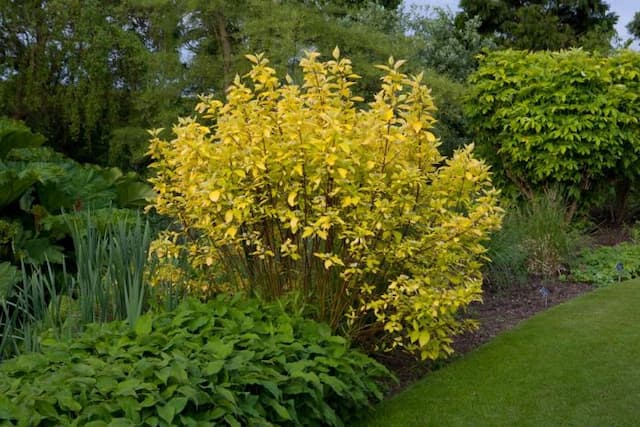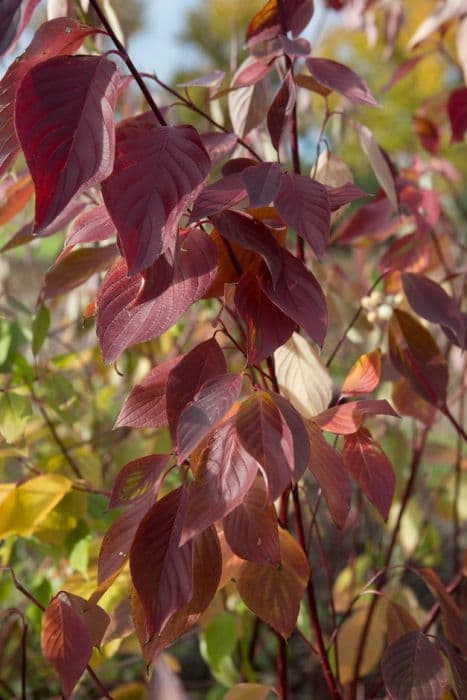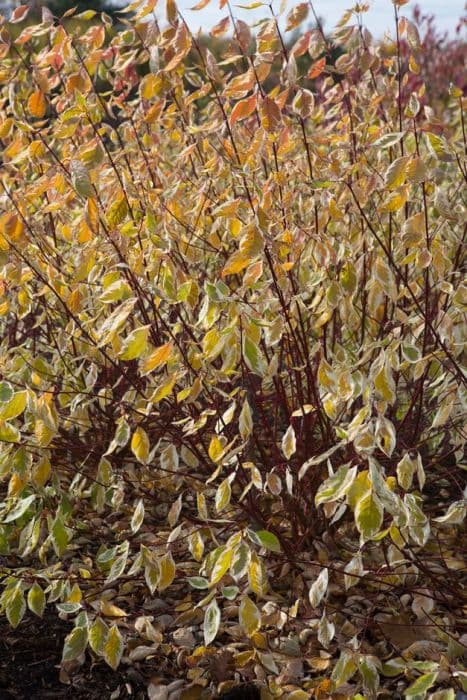Siberian Dogwood Cornus alba 'Sibirica'

ABOUT
Cornus alba 'Sibirica', commonly known as Siberian dogwood, is a deciduous shrub with multiple stems that often grow in a rounded shape. Its leaves are variegated, displaying a mix of green and white colors during the growing season. These leaves are typically oval to lance-shaped, with pointed tips and arranged in opposite pairs along the stems. As the seasons change, one of the most striking features of the Siberian dogwood becomes evident: its bright red stems that provide a stark contrast against the winter landscape, becoming even more prominent after the leaves have fallen. In spring, the Siberian dogwood blooms with small clusters of creamy white flowers, creating a gentle, frothy appearance. These are followed by clusters of blue-white berries that attract birds and other wildlife. The bark of this shrub is also noteworthy, peeling in spots and adding additional texture and interest to the plant's appearance, especially in the winter months when the foliage has dropped. The changing seasons bring about a dynamic transformation in the Siberian dogwood, making it a plant with multi-season interest due to its evolving color palette and structural qualities.
About this plant
 Names
NamesFamily
Cornaceae
Synonyms
Siberian Dogwood, Red-Barked Dogwood, White Dogwood, Tatarian Dogwood
Common names
Cornus alba 'Sibirica'.
 Toxicity
ToxicityTo humans
The Tatarian dogwood, which is commonly known as the plant named Cornus alba 'Sibirica', is not considered highly toxic to humans. However, as with many ornamental plants, it is not intended for consumption. If ingested in large quantities, parts of the plant might cause mild stomach upset or diarrhea, but serious poisoning is rare. While the fruit can be mildly toxic if eaten in significant amount, there’s usually no severe toxicity associated with this plant.
To pets
The Tatarian dogwood is not commonly known to be toxic to pets. However, it is generally recommended to prevent pets from ingesting plants that are not part of their usual diet. If a pet does consume parts of the Tatarian dogwood, they may experience mild gastrointestinal upset, such as vomiting or diarrhea. Significant toxicity is unusual, but it's always wise to monitor your pet for any signs of distress after ingesting plant material, and consult with a veterinarian if you are concerned.
 Characteristics
CharacteristicsLife cycle
Perennials
Foliage type
Deciduous
Color of leaves
Green
Flower color
White
Height
6 feet (1.8 meters)
Spread
5 feet (1.5 meters)
Plant type
Shrub
Hardiness zones
3
Native area
Asia
Benefits
 General Benefits
General Benefits- Ornamental Appeal: Cornus alba 'Sibirica', also known as Siberian Dogwood, has striking red stems that provide a burst of color in the winter landscape.
- Wildlife Habitat: It offers shelter and its fruits serve as a food source for birds and other wildlife.
- Seasonal Interest: This plant features white flowers in spring and colorful leaves in the fall, providing year-round visual interest.
- Erosion Control: The fibrous root system can help to stabilize soil, reducing erosion on slopes and in garden beds.
- Low Maintenance: Siberian Dogwood is relatively easy to care for, requiring minimal pruning and capable of thriving in a range of soil types.
- Versatility: It can be used in various landscape designs, including as a hedge, in mixed shrub borders, or as a specimen plant.
- Tolerance of Conditions: This dogwood tolerates a variety of conditions including cold climates and urban pollution.
- Privacy Screen: When planted in a row or grouping, it can create an effective visual barrier for privacy.
 Medical Properties
Medical PropertiesThis plant is not used for medical purposes.
 Air-purifying Qualities
Air-purifying QualitiesThis plant is not specifically known for air purifying qualities.
 Other Uses
Other Uses- Winter Interest: Siberian dogwood has bright red branches that provide striking visual interest in the winter landscape when most plants have lost their leaves.
- Wildlife Habitat: Birds are attracted to the white berries that Siberian dogwood produces, which can provide a valuable food source during colder months.
- Natural Dye: The bark of Siberian dogwood can be used to create a light brown or tan dye for fabrics and yarns.
- Craft Material: The stems can be harvested and used in basket weaving or as decorative elements in floral arrangements.
- Erosion Control: Its dense root system can help stabilize soil on slopes and prevent erosion.
- Privacy Screen: When planted in rows or as a hedge, Siberian dogwood can provide privacy to a garden space throughout the year.
- Windbreaks: The thick foliage and sturdy stems can serve as a windbreak, protecting more delicate plants and reducing wind speed in an area.
- Stream or Pond Edges: The plant can be used to naturalize the edges of streams or ponds, blending the water feature into the surrounding landscape.
- Pollinator Garden: Siberian dogwood flowers attract bees and other pollinators, contributing to the health of pollinating insect populations.
- Photography: The contrasting colors of the red branches against snow provide a beautiful subject for winter and nature photography.
Interesting Facts
 Feng Shui
Feng ShuiThe Red Twig Dogwood is not used in Feng Shui practice.
 Zodiac Sign Compitability
Zodiac Sign CompitabilityThe Red Twig Dogwood is not used in astrology practice.
 Plant Symbolism
Plant Symbolism- Resilience: Siberian Dogwood, with its ability to withstand harsh Siberian winters, symbolizes resilience and the ability to endure difficult conditions.
- Protection: Its hardy nature implies a sense of protection and the ability to safeguard oneself against adversity.
- Purity: The bright white berries are often associated with purity and innocence.
- Calm: The soothing appearance of the Siberian Dogwood can represent calm and tranquility in one's life.
- Growth: The vigorous growth of the shrub symbolizes personal growth and development.
 Water
WaterSiberian Dogwood prefers consistent moisture, especially during its first growing season. Water it thoroughly once or twice a week, depending on the weather and soil drainage. Ensure that the soil is kept moist but not waterlogged. Each watering should provide the plant with around 1-2 gallons of water. During the hot summer months, water usage may increase, and during the cooler months, it typically decreases.
 Light
LightSiberian Dogwood thrives best in full sun to partial shade. Ideal planting spots are those that receive morning sunlight and offer some shade in the afternoon, particularly in hotter climates. The plant is versatile but its red stem color is most vibrant when it receives ample light.
 Temperature
TemperatureSiberian Dogwood grows well in a wide range of temperatures but prefers zones with winter lows that do not drop below -30 degrees Fahrenheit and summer highs that typically do not exceed 75 degrees Fahrenheit. It fares best when the temperature swings between these seasonal extremes, with a comfortable range being 50 to 75 degrees Fahrenheit for optimal growth.
 Pruning
PruningPrune Siberian Dogwood in late winter or early spring to promote strong growth and enhance its bright red winter stem color. Cut back one-third of the old stems to the ground annually, or more drastically every two to three years, which will renew the plant and maintain a desirable shape. The best time for pruning is when the plant is dormant, before new growth begins.
 Cleaning
CleaningAs needed
 Soil
SoilRed Twig Dogwood thrives in well-draining soil with a pH of 5.5 to 7.5. Mix organic compost with loam and sand to improve fertility and drainage. Mulch helps maintain soil moisture.
 Repotting
RepottingRed Twig Dogwoods planted in containers may need repotting every 2-3 years to refresh the soil and accommodate root growth. In landscapes, they typically do not need repotting.
 Humidity & Misting
Humidity & MistingRed Twig Dogwood does well in average humidity conditions outdoor and does not require specific humidity levels to thrive.
 Suitable locations
Suitable locationsIndoor
Ensure bright light, cool temps, and regular watering.
Outdoor
Plant in full sun to partial shade; mulch and water regularly.
Hardiness zone
2-7 USDA.
 Life cycle
Life cycleCornus alba 'Sibirica', commonly known as Siberian dogwood, begins its life cycle when the small, ivory-colored flowers bloom in late spring to early summer, leading to pollination and seed formation. The small blue-white berries (drupes) that follow are a food source for birds, which help in seed dispersal. The plant enters dormancy in the winter, showcasing its characteristic bright red stems that provide ornamental value during the colder months. In spring, the dogwood breaks dormancy as temperatures rise, and begins a new growth cycle with the emergence of new leaves and stems. During the vegetative stage throughout the spring and summer, the plant focuses on accumulating resources and growing both above and below the ground, strengthening its root system. Periodically, the plant should be pruned to encourage vibrant stem color and maintain a desirable shape, which is also essential for healthy growth and rejuvenation.
 Propogation
PropogationPropogation time
Late Winter-Early Spring
Propogation: The Red Twig Dogwood (Cornus alba 'Sibirica') can be propagated most successfully through hardwood cuttings. This process is typically done during the winter months when the plant is dormant. A gardener should select healthy branches from the current or previous year's growth, ensuring the cuttings are approximately 6 to 8 inches (15 to 20 centimeters) in length. Each cutting should have at least two or three nodes where leaves attach to the stem. The bottom cut should be made just below a node, and the top cut should be made just above a node. These cuttings can then be planted directly in the ground or in a pot filled with potting mix, making sure at least one node is below the soil surface, which will allow roots to develop from this point. The cuttings should be kept moist until they establish a strong root system, which may take several weeks to a few months.

![Dogwood [Baton Rouge]](/_next/image?url=https%3A%2F%2Fplants-admin.emdemapps.com%2Fimages%2Fplants%2F%2Fimages%2F604b59cf0fefd.png&w=640&q=75)


![Dogwood [Ivory Halo]](/_next/image?url=https%3A%2F%2Fplants-admin.emdemapps.com%2Fimages%2Fplants%2F%2Fimages%2F604b535cbcb9a.png&w=640&q=75)




![Dogwood [Venus]](/_next/image?url=https%3A%2F%2Fplants-admin.emdemapps.com%2Fimages%2Fplants%2F%2Fimages%2F604b58a531da1.png&w=640&q=75)